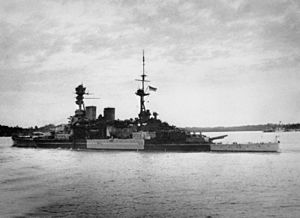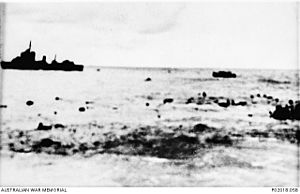Sinking of Prince of Wales and Repulse facts for kids
Quick facts for kids Sinking of Prince of Wales and Repulse |
|||||||
|---|---|---|---|---|---|---|---|
| Part of the Pacific War of World War II | |||||||
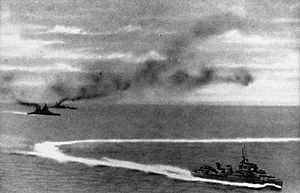 Prince of Wales (left, front) and Repulse (left, behind) after being hit by torpedoes on 10 December 1941. A destroyer, HMS Express, is manoeuvring in the foreground. |
|||||||
|
|||||||
| Belligerents | |||||||
| Commanders and leaders | |||||||
| Units involved | |||||||
| Force Z | Genzan Air Group Kanoya Air Group Mihoro Air Group |
||||||
| Strength | |||||||
| 1 battleship 1 battlecruiser 4 destroyers |
88 aircraft (34 torpedo aircraft, 51 level bombers, 3 scouting aircraft) |
||||||
| Casualties and losses | |||||||
| 1 battleship sunk 1 battlecruiser sunk 840 killed |
4 aircraft destroyed 28 damaged 2 seaplanes missing 18 killed |
||||||
The sinking of Prince of Wales and Repulse was a major sea battle during World War II. It happened on December 10, 1941, in the South China Sea. This area is off the coast of what was then British Malaya (now Malaysia) and Singapore.
In this battle, two large British warships, the battleship HMS Prince of Wales and the battlecruiser HMS Repulse, were sunk. They were attacked by land-based bombers and torpedo bombers from the Imperial Japanese Navy. This event showed how powerful air attacks could be against even the biggest warships if they didn't have air support.
The British ships were part of a group called Force Z. Their goal was to stop a Japanese invasion fleet near Malaya. However, Force Z sailed without any planes to protect them from air attacks. They were found by Japanese planes and sunk while trying to return to Singapore. The commander of Force Z, Admiral Sir Tom Phillips, died in the battle.
This loss greatly weakened the British navy in Singapore. It also showed the importance of aircraft carriers in naval battles. Just a month later, Singapore itself fell to the Japanese.
Contents
Why the Ships Were Sent
In late 1941, Winston Churchill, who was the Prime Minister of the United Kingdom, wanted to send strong warships to Asia. This was to try and stop Japan from expanding its territory. Japan had recently invaded French Indochina.
The British navy had a plan called the "Singapore Strategy." This plan was to send many large warships to Singapore if a war with Japan started. Singapore had a big naval base built for this reason. However, Britain was also fighting Nazi Germany and Fascist Italy in Europe. This meant they couldn't send all their best ships to Asia.
Churchill believed that sending even a few modern ships would scare Japan. He thought these ships could act as a "fleet in being." This means a fleet that is so strong it just sitting there would stop an enemy from acting. He decided to send the new battleship Prince of Wales and the older battlecruiser Repulse. An aircraft carrier, HMS Indomitable, was also supposed to go. But Indomitable hit the ground in the Caribbean and couldn't join them.
Some British naval leaders worried about sending these ships. They thought the new battleships were not good for hot, humid places like Malaya. For example, the Prince of Wales' radar systems for shooting down planes didn't work well in the heat. Also, its anti-aircraft ammunition got worse in the humid air.
Force Z Arrives in Singapore
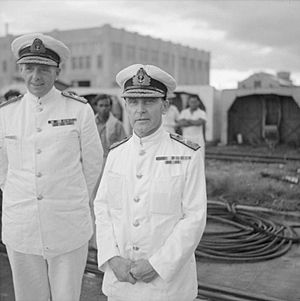
The group of ships, called Force G at first, arrived in Singapore on December 2, 1941. It included the battleship Prince of Wales, the battlecruiser Repulse, and four destroyers. They were then renamed Force Z.
Admiral Sir Tom Phillips was put in charge of this new fleet. Other British and American warships were also in Singapore or on their way. But many of them were too slow or needed repairs.
Japanese Preparations
When Churchill announced that Prince of Wales and Repulse were going to Singapore, Japan reacted. Admiral Isoroku Yamamoto sent more Mitsubishi G4M bombers to the area. These planes joined other bombers already there.
Japanese pilots trained hard for this mission. They practiced attacking ships at very low altitudes. They also learned to fly long distances over the ocean to find moving targets. This was the first time in the war that bombers were specially trained to sink ships.
The Battle Begins
On December 8, 1941, Japanese bombers attacked Singapore early in the morning. Prince of Wales and Repulse fired their anti-aircraft guns, but no planes were shot down. The ships were not damaged. On the same day, Japan began its invasion of Malaya.
News then arrived that Pearl Harbor had been attacked by Japan. Eight US battleships were sunk or badly damaged. This meant the US fleet could not help the British in Singapore. Admiral Phillips knew his two big ships were not enough to fight the Japanese alone.
However, with the Japanese invading Malaya, Phillips felt he had to act. He decided to take his ships out to sea to try and stop the Japanese invasion convoys.
No Air Cover
Phillips did not believe the RAF had enough fighter planes to protect his ships. One squadron, No. 453 Squadron RAAF, had 10 planes meant to protect Force Z. But Phillips decided not to use them for constant air cover.
He made this choice for a few reasons:
- He thought Japanese planes couldn't fly so far from land.
- He believed his big ships were too strong to be sunk by air attacks.
- He didn't know how good Japanese planes and torpedoes were.
- Like many British naval officers, he underestimated the Japanese fighting skills.
At that time, no large warship moving at sea had been sunk only by air attack. The Prince of Wales had advanced anti-aircraft systems. But the hot, humid weather in Malaya made its radar systems not work well. Its anti-aircraft ammunition also got worse.
Force Z Sails Out
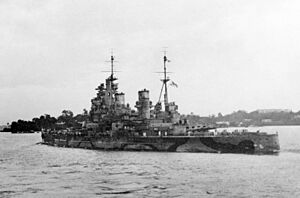
Force Z left Singapore at 5:10 PM on December 8. Admiral Phillips hoped to attack the Japanese invasion fleet near Singora on December 10. If he had left a day earlier, he might have found the Japanese ships before their planes arrived.
On December 9, a Japanese submarine, I-65, spotted Force Z. The submarine followed the British ships for five hours and sent their location by radio. Phillips didn't know he was being watched.
The Japanese air force quickly prepared their planes for an attack. They switched from bombs to torpedoes. Japanese warships also started moving to intercept Force Z.
Later that day, Japanese planes spotted Force Z again. Phillips changed course to trick the planes, then turned back towards Singapore under the cover of darkness. One of his destroyers, Tenedos, was sent back to Singapore because it was low on fuel.
The Japanese tried a night air attack, but bad weather stopped them from finding the ships.
The Return to Singapore
That night, a Japanese plane accidentally dropped a flare over a Japanese ship, thinking it was Prince of Wales. The British ships saw the flare and worried they had been found. Phillips decided to cancel the mission and return to Singapore.
On the way back, a Japanese submarine, I-58, spotted them and fired torpedoes, but missed. The British ships didn't even know they had been attacked. The submarine's report reached Japanese air headquarters. Early on December 10, many Japanese planes took off to find Force Z.
The Japanese Air Attack
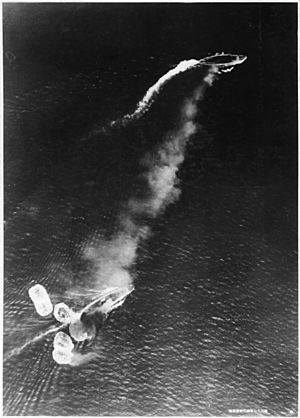
On December 10, Phillips received a report of Japanese landings at Kuantan, Malaya. He headed towards Kuantan, but didn't tell anyone his plans. This meant no air cover was sent to protect him there.
At 10:00 AM, a Japanese scout plane found Force Z. It sent a message with their exact location. The Japanese planes, which had been searching farther south, quickly headed towards the British ships. Because they were low on fuel, they attacked in small groups as they arrived.
The first wave of Japanese planes attacked Repulse at 11:13 AM. They dropped bombs. One bomb hit Repulse, but it didn't cause serious damage. The ship kept moving fast.
Around 11:40 AM, 17 Japanese torpedo bombers attacked. Eight focused on Repulse, and nine attacked Prince of Wales. One plane was shot down by Prince of Wales' guns. This attack hit Prince of Wales with one torpedo near its back. This hit caused a lot of damage. Water rushed into the ship, and its speed dropped. The ship also started to lean to one side. This made many of its anti-aircraft guns unable to fire at low-flying planes.
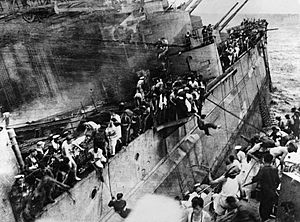
Around 12:20 PM, another group of 26 Japanese bombers attacked. Prince of Wales was hit by three more torpedoes on its other side. These hits caused even more damage and stopped another one of its propellers.
At the same time, Repulse was also attacked by torpedoes from both sides. Repulse had dodged 19 torpedoes earlier, but this time it was hit by at least four. Captain William Tennant ordered his crew to abandon ship. Repulse quickly leaned over and sank stern first at 12:33 PM. Many sailors were lost.
Prince of Wales was now moving very slowly with only one propeller. It was still firing its guns, but a bomb hit its deck. This bomb exploded below deck, causing many casualties. Prince of Wales began to lean heavily to one side. The destroyer HMS Express came alongside to rescue the wounded and other crew members. The order to abandon ship was given. Prince of Wales then rolled over and sank stern first at 1:18 PM.
The Japanese planes had hit the ships with eight torpedoes in total. They lost only three planes during the attack. The air cover from No. 453 Squadron RAAF arrived at 1:18 PM, just as Prince of Wales sank. They saw a Japanese scout plane, but it escaped.
After the Battle
The destroyers Electra and Vampire rescued survivors from Repulse. Express rescued survivors from Prince of Wales. In total, 840 sailors died: 513 from Repulse and 327 from Prince of Wales.
Admiral Phillips and Captain John Leach of Prince of Wales chose to go down with their ship. Captain William Tennant of Repulse was rescued.
As the Japanese bombers returned to their bases, a second wave of planes was getting ready to attack. But they soon got news that the British ships were sunk. The attack was called off. The next day, a Japanese pilot flew over the battle site and dropped flowers into the sea. He did this to honor the brave sailors from both sides who had died.
What Happened Next
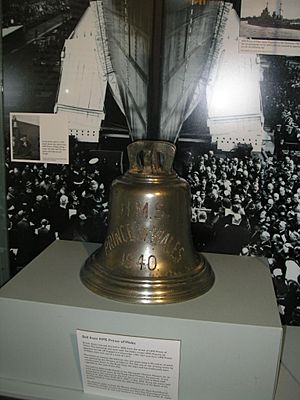
The sinking of Prince of Wales and Repulse was a huge shock. It showed that even the strongest battleships could be destroyed by air power if they didn't have air protection. These were the first large warships moving at sea to be sunk only by air attack.
This event, along with the attack on Pearl Harbor, meant the Allies had very few big warships left in the Pacific. It made the Allies realize how important aircraft carriers were. Carriers became key to fighting back against Japan.
The loss of the ships also lowered morale in British colonies in Asia. This led to some unrest, like the Cocos Islands mutiny.
The Ships Today
The wrecks of Repulse and Prince of Wales were found after the war. They lie upside down on the seabed. Flags of the Royal Navy are attached to the wrecks and are changed regularly by divers.
In 2002, the bell from Prince of Wales was taken from the wreck. This was done to protect it from thieves. The bell is now on display at the Merseyside Maritime Museum in Liverpool. It is a tradition for British Royal Navy ships to hold a remembrance service when they pass over the wreck site.
In 2007, a detailed survey of the wrecks was done. This survey helped experts understand exactly how the ships were damaged and sunk. In 2014, it was reported that scrap-metal dealers were damaging the wrecks with explosives.
Memorial
On December 10, 2011, a memorial was dedicated at The National Memorial Arboretum in the UK. This memorial honors the sailors who died when Prince of Wales and Repulse were sunk. Some of the few surviving crew members attended the ceremony.


